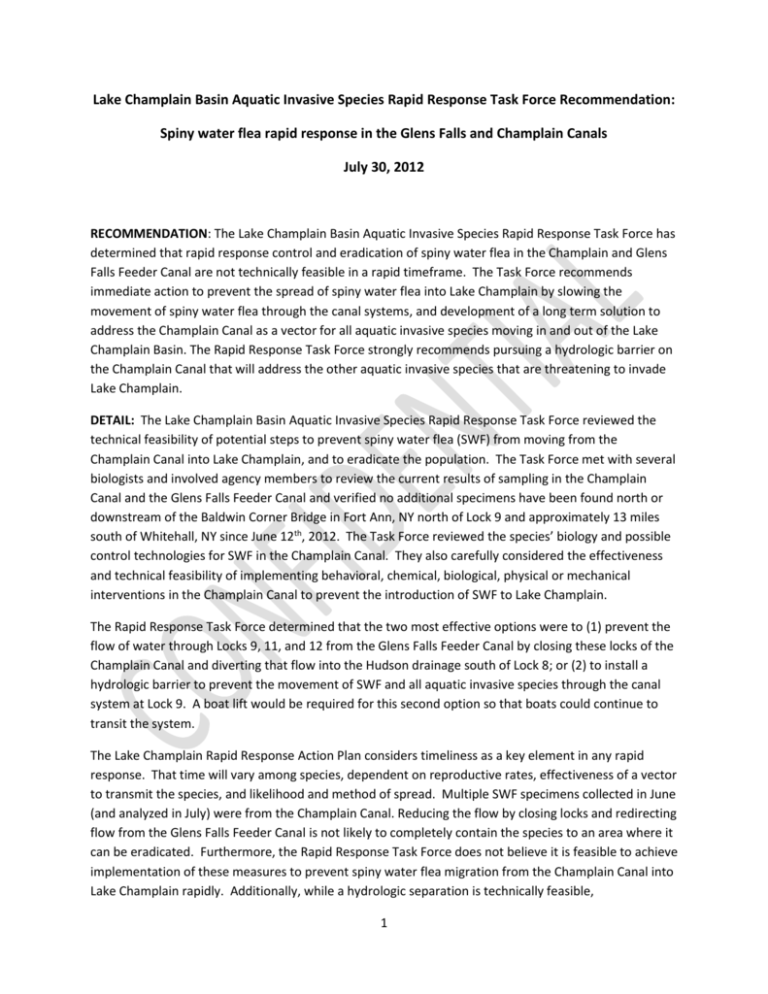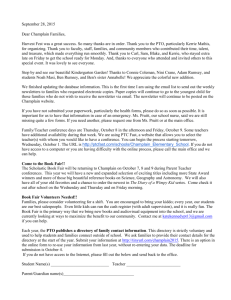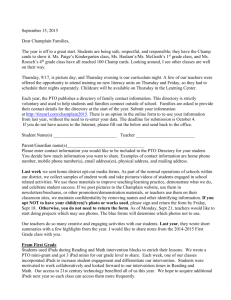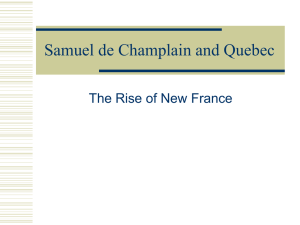CONFIDENTIAL Lake Champlain Basin Aquatic Invasive Species
advertisement

Lake Champlain Basin Aquatic Invasive Species Rapid Response Task Force Recommendation: Spiny water flea rapid response in the Glens Falls and Champlain Canals July 30, 2012 RECOMMENDATION: The Lake Champlain Basin Aquatic Invasive Species Rapid Response Task Force has determined that rapid response control and eradication of spiny water flea in the Champlain and Glens Falls Feeder Canal are not technically feasible in a rapid timeframe. The Task Force recommends immediate action to prevent the spread of spiny water flea into Lake Champlain by slowing the movement of spiny water flea through the canal systems, and development of a long term solution to address the Champlain Canal as a vector for all aquatic invasive species moving in and out of the Lake Champlain Basin. The Rapid Response Task Force strongly recommends pursuing a hydrologic barrier on the Champlain Canal that will address the other aquatic invasive species that are threatening to invade Lake Champlain. DETAIL: The Lake Champlain Basin Aquatic Invasive Species Rapid Response Task Force reviewed the technical feasibility of potential steps to prevent spiny water flea (SWF) from moving from the Champlain Canal into Lake Champlain, and to eradicate the population. The Task Force met with several biologists and involved agency members to review the current results of sampling in the Champlain Canal and the Glens Falls Feeder Canal and verified no additional specimens have been found north or downstream of the Baldwin Corner Bridge in Fort Ann, NY north of Lock 9 and approximately 13 miles south of Whitehall, NY since June 12th, 2012. The Task Force reviewed the species’ biology and possible control technologies for SWF in the Champlain Canal. They also carefully considered the effectiveness and technical feasibility of implementing behavioral, chemical, biological, physical or mechanical interventions in the Champlain Canal to prevent the introduction of SWF to Lake Champlain. The Rapid Response Task Force determined that the two most effective options were to (1) prevent the flow of water through Locks 9, 11, and 12 from the Glens Falls Feeder Canal by closing these locks of the Champlain Canal and diverting that flow into the Hudson drainage south of Lock 8; or (2) to install a hydrologic barrier to prevent the movement of SWF and all aquatic invasive species through the canal system at Lock 9. A boat lift would be required for this second option so that boats could continue to transit the system. The Lake Champlain Rapid Response Action Plan considers timeliness as a key element in any rapid response. That time will vary among species, dependent on reproductive rates, effectiveness of a vector to transmit the species, and likelihood and method of spread. Multiple SWF specimens collected in June (and analyzed in July) were from the Champlain Canal. Reducing the flow by closing locks and redirecting flow from the Glens Falls Feeder Canal is not likely to completely contain the species to an area where it can be eradicated. Furthermore, the Rapid Response Task Force does not believe it is feasible to achieve implementation of these measures to prevent spiny water flea migration from the Champlain Canal into Lake Champlain rapidly. Additionally, while a hydrologic separation is technically feasible, 1 implementation will require substantial design, development, engineering and financing that cannot happen quickly. Other factors have to be considered. A significant factor is that the New York State Canal Corporation is required by law to keep the waters of the Champlain Canal open and navigable. Under the Lake Champlain Basin Rapid Response Action Plan for Aquatic Invasive Species, spread prevention measures are immediately pursued if rapid response is found not to be feasible for containment and eradication. Unfortunately, that is likely to be the case with SWF. The Rapid Response Task Force will support efforts by Federal, State and local agencies to pursue ways to slow the movement of SWF through the canal system, as well as a long term solution to prevent the movement of all aquatic invasive species through the Champlain Canal. The Lake Champlain Basin Aquatic Invasive Species Rapid Response Task Force Spread Prevention Measure Recommendations Include: 1. Pursue options to redirect surplus flow in the Champlain Canal away from Lake Champlain. The Rapid Response Task Force will work with the Canal Corporation to explore the feasibility of redirecting surplus water to the south, around Lock 8, and back into the Hudson system. Currently, surplus water drains around Lock 9 into the Champlain drainage. 2. Initiate the Champlain Canal Barrier Feasibility Study. The Lake Champlain Basin Program, including the Aquatic Nuisance Species Subcommittee and the U.S. Army Corps of Engineers will work with the NY State Canal Corporation to support efforts to obtain additional resources required to complete the feasibility study and the preconstruction engineering and design for the study’s preferred option. 3. New York State Department of Environmental Conservation and other partners will work to increase sampling in the Champlain and Glens Falls Feeder canals, and include new sampling techniques. They will also expand sampling in the Champlain Canal to include fish, which may consume SWF. Gut analyses will be used to help determine the extent of SWF spread in the canal. 4. The Rapid Response Task Force urges the New York Canal Corporation to issue a public service announcement alerting canal traffic to presence of SWF and sharing an effective spread prevention message. 5. The Lake Champlain Basin Aquatic Nuisance Species Subcommittee will support development of a predictive model of which lakes are most susceptible to SWF invasions and target outreach and lake steward/greeter programs. 6. Lake Champlain Basin partners will expand the lake steward/greeter program and include more information on SWF in education and outreach trainings. Consult with the Canal Corporation for canal designated steward(s). 7. The Lake Champlain Basin Aquatic Nuisance Subcommittee will identify resources and a lead partner to print more SWF watch cards and distribute them to key user groups. The Subcommittee will also develop educational materials on aquatic invasive species spread prevention to distribute to canal users at Locks 1 and 12. 2








